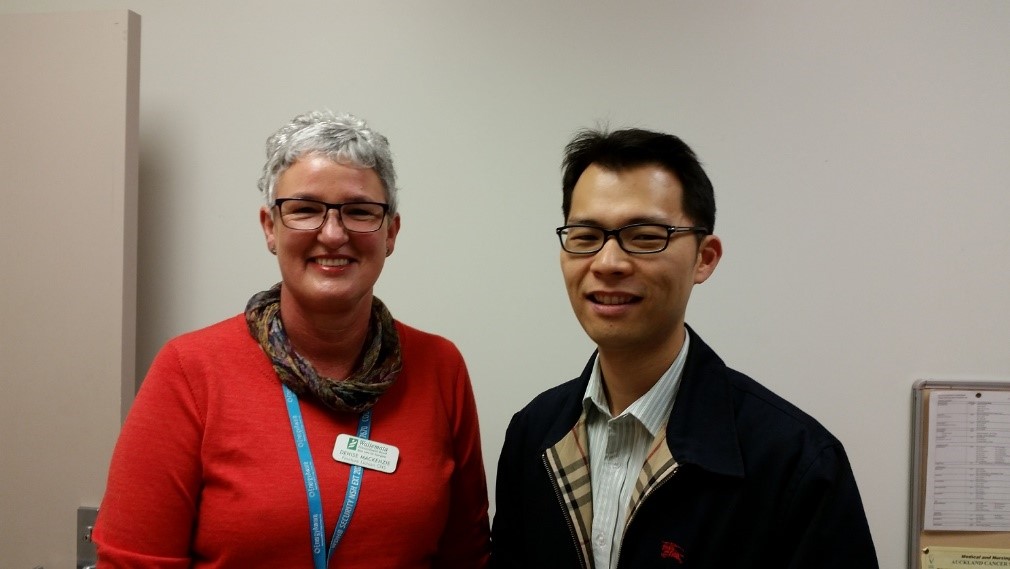This case study was kindly drafted by Dr. David Kim of Waitemata DHB.
The Waitemata DHB Fracture Liaison Service (FLS) was established in late 2012 after a period of careful planning by a coalition of multi-department representatives. The aim of developing our FLS was to prevent fractures in those at highest risk of future fractures, by capturing fragility fractures presenting to our hospitals and implementing appropriate assessment and treatment for osteoporosis. The project was initially led by Dr. Joe Singh, Geriatrician, with a guiding support from Paul Mitchell, Acting Chair of Osteoporosis New Zealand with his extensive knowledge and experience with FLS abroad. We were also fortunate to have research grant from Merck Sharp & Dohme (MSD) to fund 0.5 FTE Fracture Liaison Nurse, and were the first DHB to have dedicated FLS nurse.
Our inaugural fracture liaison nurse was Maria Harrison who, with the oversight of Dr. Joe Singh, was instrumental in setting up the infrastructure for the service in 2012 and 2013. Endocrinology department, led by Dr. Rick Cutfield, provided extra bone mineral density (DXA) scans for the FLS implementation. Regular multidisciplinary meetings were held with presence of relevant representatives from various subspecialties (Older People’s Health, Endocrinology, Orthopaedics and Emergency Medicine). Endocrinology Service Manager, Brian Millen, has been regularly and intimately involved with FLS work throughout. We successfully secured DHB funding in 2013 for ongoing FLS at WDHB.
In 2013, we started capturing fragility fracture cases, some from inpatient wards but, mainly from Orthopaedic fracture clinic. One hundred and sixty cases were captured in 2013, with the majority being fractures of the wrist and humerus, but also some vertebrae, hip, and ankle fractures. Laboratory investigations were done and DXA was performed in selected cases, with appropriate therapy started or recommended. Our service attained the ‘Bronze’ status from the International Osteoporosis Foundation’s Capture the Fracture® Campaign on the basis of our 2013 work.

There was a change of team at the end of 2013. Denise MacKenzie was appointed as our new FLS nurse and Dr. David Kim, Endocrinologist, as the lead clinician. A protocol was fine-tuned for implementation of more systematic and streamlined case detection, assessment and treatment. We are continuing to capture those over the age of 50 years with fragility fracture from the fracture clinic, but are now detecting a lot more inpatient cases, especially the hip fractures. All captured patients are either seen or contacted via a phone call by Denise. She explains the role of FLS to the patient and offer appropriate screening. All agreeable patients go through selected laboratory investigations, and a large proportion of patients have DXA (those aged between 50 and 75 years) to aid treatment decision. After completion of the assessment, each individual’s case is discussed by Denise and Dr. Kim, and a brief clinical letter is addressed to the patient’s GP. Complex cases, especially those with recurrent or multiple fragility fractures, are arranged to be seen in Endocrine outpatient clinic.

Going forward, we would like to continue to develop and grow our service. We are looking at opportunities for additional funding to increase FLS co-ordinator time, as we are currently unable to capture a significant proportion of fragility fractures at our two hospitals. We are currently working on systematic capture of larger number of fracture patients via clinical coding and radiology. We are actively planning to appoint a dedicated falls prevention programme with a FLS Physiotherapist.
With our experience thus far, we believe that following are the key elements in successful FLS establishment and implementation:
- Engaging DHB management/leadership early to secure funding and support
- Gathering interested parties from various subspecialties of the DHB with regular and formal planning meeting
- Having a ready access to funded DXA scans
- Clearly defining the target population, means of capturing cases, protocol for evaluation and treatment implementation
- Active and regular clinician input with the FLS co-ordinator for management decisions
Active and regular clinician input with the FLS co-ordinator for management decisions





 Print
Print